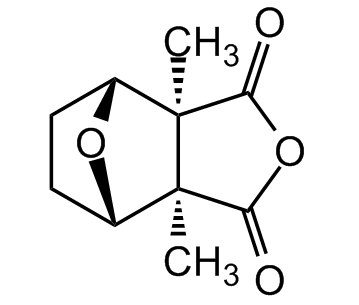Cantharidin
| Code | Size | Price |
|---|
| CDX-C0643-M100 | 100 mg | £121.00 |
Quantity:
| CDX-C0643-M500 | 500 mg | £450.00 |
Quantity:
Prices exclude any Taxes / VAT
Overview
Regulatory Status: RUO
Shipping:
AMBIENT
Storage:
+4°C
Images
Documents
Further Information
Alternate Names/Synonyms:
3a,7a-Dimethylhexahydro-4,7-epoxyisobenzofuran-1,3-dione; 7a-Dimethylhexahydro-3a,4,7-epoxyisobenzofuran; Cantharidine; Hexahydro-3a,7a-dimethyl-4,7-epoxyisobenzofuran-1,3-dione; NSC61805; BRN 0085302
Appearance:
White to off-white powder.
CAS:
56-25-7
Class:
6.1
EClass:
32160000
Form (Short):
liquid
GHS Symbol:
GHS06
Handling Advice:
Protect from light and moisture.
Hazards:
H300, H315, H319, H335
InChi:
InChI=1S/C10H12O4/c1-9-5-3-4-6(13-5)10(9,2)8(12)14-7(9)11/h5-6H,3-4H2,1-2H3/t5-,6+,9+,10-
InChiKey:
DHZBEENLJMYSHQ-XCVPVQRUSA-N
Long Description:
Chemical. CAS: 56-25-7. Formula: C10H12O4. MW: 196.2. . Cantharidin is a natural toxin produced by blister beetles. It is a selective protein phosphatase 2A (PP2A) inhibitor and weakly inhibits protein phosphatases 1 (PP1). Displays > 500-fold selectivity over PP2B. Induces G2/M phase arrest and apoptosis, suppresses autophagy and inhibits cell proliferation. It is used topically against Molluscum contagiosum virus (MCV) infections and associated warts. Has shown potent anticancer activities on many types of human cancer cells.
MDL:
MFCD00134968
Molecular Formula:
C10H12O4
Molecular Weight:
196.2
Package Type:
Vial
PG:
III
Precautions:
P305, P351, P338
Product Description:
Cantharidin is a natural toxin produced by blister beetles. It is a selective protein phosphatase 2A (PP2A) inhibitor and weakly inhibits protein phosphatases 1 (PP1). Displays > 500-fold selectivity over PP2B. Induces G2/M phase arrest and apoptosis, suppresses autophagy and inhibits cell proliferation. It is used topically against Molluscum contagiosum virus (MCV) infections and associated warts. Has shown potent anticancer activities on many types of human cancer cells.
Purity:
>98% (HPLC)
Signal word:
Danger
SMILES:
C[C@]12[C@](C(OC2=O)=O)(C)[C@@H]3CC[C@H]1O3
Solubility Chemicals:
Soluble in DMSO or ethanol.
Transportation:
Excepted Quantity
UN Nummer:
2811
UNSPSC Category:
Biochemical Reagents
UNSPSC Number:
12352200
Use & Stability:
Stable for at least 2 years after receipt when stored at +4°C.
References
(1) Y.M. Li & J.E. Casida; PNAS 89, 11867 (1992) | (2) Y.M. Li, et al.; Biochem. Pharmacol. 46, 1435 (1993) | (3) R.E. Honkanen, et al.; FEBS Lett. 330, 283 (1993) | (4) W. Li, et al.; Cancer Sci. 101, 1226 (2010) | (5) L.P. Deng, et al.; Curr. Med. Chem. 20, 159 (2013) (Review) | (6) A.P. Le, et al.; Oncol. Rep. 35, 2970 (2016) | (7) X. Sun, et al.; Mol. Cells 39, 869 (2016) | (8) H.C. Li, et al.; Cell Physiol. Biochem. 43, 1829 (2017) | (9) G. Wang , et al.; Curr. Med. Chem. (Epub ahead of print) (2017)
Related Products
| Product Name | Product Code | Supplier | 2-Bromoacrolein | CDX-B0251 | Chemodex | Summary Details | |||||||||||||||||||||||||||||||||||||||||||||||||||||||||||||||||||||||||||||||||||||||||||||
|---|---|---|---|---|---|---|---|---|---|---|---|---|---|---|---|---|---|---|---|---|---|---|---|---|---|---|---|---|---|---|---|---|---|---|---|---|---|---|---|---|---|---|---|---|---|---|---|---|---|---|---|---|---|---|---|---|---|---|---|---|---|---|---|---|---|---|---|---|---|---|---|---|---|---|---|---|---|---|---|---|---|---|---|---|---|---|---|---|---|---|---|---|---|---|---|---|---|---|---|
| N-(3-Bromopropyl)-7-nitro-2,1,3-benzoxadiazol-4-amine | CDX-B0268 | Chemodex | Summary Details | ||||||||||||||||||||||||||||||||||||||||||||||||||||||||||||||||||||||||||||||||||||||||||||||||
| 2-Chlorocyclohepta-2,4,6-trienone | CDX-C0181 | Chemodex | Summary Details | ||||||||||||||||||||||||||||||||||||||||||||||||||||||||||||||||||||||||||||||||||||||||||||||||



